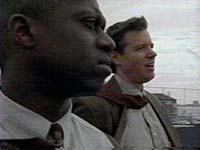Classic TV
 I’ve been watching the first season of Homicide: Life on the Street, the predecessor to the HBO’s marvelous Baltimore cop-drama, The Wire. Like The Wire, it’s a coarse, deeply cynical procedural about the hard-scrabble lives of Baltimore detectives fighting a two-front war against both petty, narcissistic city bureaucracy and a skeptical, resistant public. And though it doesn’t have the intricate, season-long story arcs or fiendishly obscure dialog of its pay-cable counterpart, in terms of density and difficulty, it seems to push the limits of network television about as far as they’ll go. Almost fifteen years after its initial network run, it’s still a chilling, savvy look at the grim business of playing the unloved, underpaid housemaid to a city's murderers. It’s not just compelling storytelling (though it certainly is that), it’s also a resonant cultural item—a diorama of death and urban decay set against the creaking machine of city bureaucracy.
I’ve been watching the first season of Homicide: Life on the Street, the predecessor to the HBO’s marvelous Baltimore cop-drama, The Wire. Like The Wire, it’s a coarse, deeply cynical procedural about the hard-scrabble lives of Baltimore detectives fighting a two-front war against both petty, narcissistic city bureaucracy and a skeptical, resistant public. And though it doesn’t have the intricate, season-long story arcs or fiendishly obscure dialog of its pay-cable counterpart, in terms of density and difficulty, it seems to push the limits of network television about as far as they’ll go. Almost fifteen years after its initial network run, it’s still a chilling, savvy look at the grim business of playing the unloved, underpaid housemaid to a city's murderers. It’s not just compelling storytelling (though it certainly is that), it’s also a resonant cultural item—a diorama of death and urban decay set against the creaking machine of city bureaucracy. And it seems to me that it’s this element of shows like Homicide, and now The Sopranos, The Wire, maybe even Battlestar Galactica, along with the rise of the DVD, that puts a bit of a crack into the “Myth of Classic TV” as proffered by critics like Terry Teachout and Mark Steyn. In his latest Atlantic column, Steyn references Teachout, and then writes:
Indeed, the more “classic” your show, the more ephemeral it is. Getting into Ovid or Gregorian chant is a piece of cake next to getting into thirtysomething fifteen years on. Conceivably, one might find oneself in a motel room unable to sleep at four in the morning and surfing the channels come across St. Elsewhere. But they made 137 episodes of multiple complex interrelated plotlines all looping back to Episode 1: if you’ve never seen it before and you stumble on Episode 43, who the hell are all these people and what are they on about? By comparison, if you happen to catch, say, an episode of Naked City from the late ’50s, you might not know who the detectives are or recognize Billy May’s wailing theme tune, and the whole monochrome thing might be a bit of a downer, but you can still pass a pleasant hour with a self-contained one-hour cop drama. The “better” television got at its art, the more transient it became. I doubt The Sopranos will be an exception to this rule. Ninety percent of all the people who’ll ever be into it are already into it.
Steyn is certainly correct to say that shows like Homicide don’t lend themselves to the trivialities of syndicated kitsch. The bland background hum required for good afternoon cable and late-night channel surfing isn’t really a good mix with the drawn-out ambiguities and complexities of these shows. And if cable reruns were all we had, then that would be that.
But television, especially of the HBO variety, is becoming more novel-like, and DVD box sets are allowing us to approach these shows in a way that preserves—even enhances—their novel-like aspects. Binge-watching these shows in commercial free, multi-episode gulps is a perfect way to experience the "multiple complex interrelated plotlines" that Steyn sees as a flaw in regular broadcast viewing. The rise of the DVD medium means that a show like Homicide, which, as with an excellent novel, provides both an accurate portrayal of a place in time and a gripping narrative populated by scads of well-crafted characters, is no longer consigned to the wastelands of syndication.
Even the physicality of the DVD medium lends it the sheen of a collector’s item, giving it roughly the same permanence, as well as personal significance, as a book on a shelf. A mid-afternoon rerun requires nothing of you; you can turn it off, flip the channel, fall asleep—you get no say as to when or whether it airs. But a DVD is yours; you chose to buy it, to put it on your shelf, and eventually to sit and watch it. In doing so, you bestow importance on it. You may not remember what aired at 9 p.m. on Thursdays a decade ago, but you’ll remember what’s on your shelf.
As our culture becomes more visual and more technology-dependent, we’re also seeing a muddying of the boundaries between imagery and text (witness the surge of video blogs on YouTube supplanting the text-blogs of MySpace and Blogger), meaning that film—yes, even television—is simply going to be less stigmatized as a “lower art.” Add all of this to the increasing migration of the long-form narrative from novel to television, and it seems to me that these shows will resonate—and yes, maybe even become "classic."

0 Comments:
Post a Comment
Subscribe to Post Comments [Atom]
<< Home